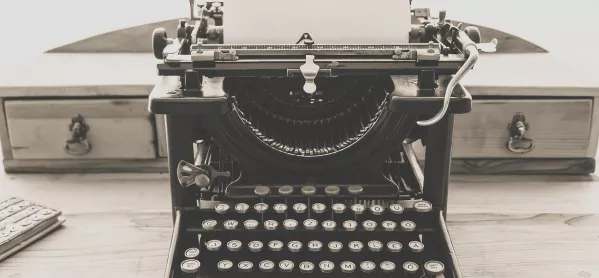- Home
- Why every 21st-century classroom should have a manual typewriter
Why every 21st-century classroom should have a manual typewriter

The year was 1990, I was 12, and our class was braced for our business studies lesson. But rather than learning about interest rates, and how to apply for The Apprentice, we were poised, our fingers caressing the home keys of the hulking typewriters in front of us.
Even then, these relics from my comprehensive’s secondary-modern past seemed a little out of place. After all, we were already getting to grips with the thrills of word processing in ICT lessons. But we humoured our teacher, Mrs Barker (no relation), who insisted our term of typing lessons would come in very handy indeed should we embark on the glamour of an office job.
I’m not sure how useful those classes were then, and they certainly wouldn’t be now. Babies are born typing messages into mobile phones and autocorrect can deal with most anagrams we throw at it. But while typing lessons may not have a place in modern schools, I’m certain that typewriters do.
Don’t write me off as an old East London hipster who fetishizes old tech (I am, but that’s beside the point). This is about far more than nostalgia or a trend for mid-century modern office equipment: I truly believe they are an amazing and cost-efficient learning resource that every primary classroom should have.
I first bought my typewriter (£30 off Ebay) because I had a feeling in my bones that a big, chunky, tippety-tapping machine would encourage my primary-age children to do some writing outside of school. While they love to draw cartoons and read lots of books, they equate writing and composition with their dreaded literacy lessons and handwriting practice.
I rarely saw them pick up a pen and put down their thoughts.
They seemed very inhibited as their pens hovered over the paper. Attempts at writing on the computer were better, but inevitably descended into YouTube sessions.
But from the moment the Olympia Monica typewriter arrived, they were hooked.
From the pleasing clicks as you roll in the paper to the uplifting ping when you reach the end of a line, they clearly found something fascinating about this form of writing. Our particular machine is a very physical affair and producing a few paragraphs of type feels like an athletic outing - something modern kids could do with more of.
They soon discovered they could write horror stories in bright red and rip the story out of the carriage with a flourish, sticking it on the wall.
My eldest has discovered he can write scathing reviews of the films he has watched on it...there’s no power trip like bashing out a hatchet job on a manual typewriter. There’s a sense of immediacy and control you don’t get on a laptop.
When they are upset, I encourage them to type out a few angry paragraphs - the mere act of pounding the keys seems to help squeeze out their demons.
Imagine if children had a chance to regularly use a typewriter at school? The full sensory experience it offers is one little-afforded to children today, where it’s sometimes a struggle to find the “on” button on certain brands of tech.
And maybe the fact you can’t really delete your mistakes is good for the anxious generation of perfectionist children our education system has bred - imperfection is all part of the charm.
From the teachers’ point of view, there are no frustrating print queues, work isn’t accidentally sent to the other end of the building for printing, and loading a new ribbon can be done by a child.
But typewriters are not just great for encouraging free expression and a morning workout. Think of the scope they have for the D&T curriculum. The mechanics of a typewriter are endlessly fascinating. Why not buy a broken one in a charity shop and ask a group of children to dismantle it (filling out the appropriate risk assessment first)?
As an extension exercise, ask them to put it back together again. Tell them it’s fine to fail when it all goes wrong.
The typewriter is also the best talking point; the best history lesson: Who invented it? Who used them? What was the typing pool? Why was typing once seen as a girls’ job? There are so many questions to ask and try to answer.
The only small drawback of introducing a typewriter to your classroom is the feeling that former education secretary Michael Gove - who has a famously retro approach to life and learning - would have liked the idea.
Irena Barker is a freelance journalist who uses her typewriter to write angry notes to her kids about the state of their bedroom
Keep reading for just £1 per month
You've reached your limit of free articles this month. Subscribe for £1 per month for three months and get:
- Unlimited access to all Tes magazine content
- Exclusive subscriber-only stories
- Award-winning email newsletters



